
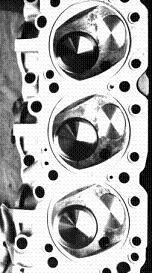
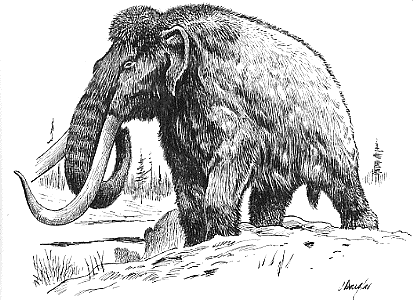
Chrysler introduced the first hemi in 1951 as a 331 CID. Later they manufactured Dodge and Desoto versions. This combustion chamber design was an outgrowth of their World War II experience. The Chrysler version grew to 392 CID in 1959 before being discontinued. At their introduction the early hemi made just over 1/2 horsepower per cubic inch. During the 10 years of their run they had climbed to 1 horse per cube. The late (426)hemi was produced from 1965 to 1971.
|
Chrysler 331, 354, 392 Dodge 241, 270, 315, 325 DeSoto 276, 291, 330, 341, 345 | Dodge and Plymouth 426 5.7-6.1 Chrysler and Dodge 345 and 372 |
The guys who ran the old hemi said the same about the 426 that some are saying about the 5.7-6.1, "it isn't a true hemi".


For it to be a true Hemi the combustion chamber depth would be 1/2 the bore, and both valves would be inclined at a 45°, making the included angle for the valves 90°, a 1936-1983 Harley Big Twin is the closest example I know of (remember the meaning of the word hemisphere, as in 1/2 a ball). The biggest problem for the true hemi is no squish, and that DEEP chamber. Both allow detonation, and a poor burn.
The old hemis (1G as they are now called) have a valve to valve (included) angle of 53°. The 426Hemi (2G) chamber is 1.6 inches deep and the valves are rolled up toward the intake (making the engine narrower). I believe the included angle is about 58.5°, and there is still no squish (pistons that fit up into the chamber can make squish, but are very heavy).
The new 5.7/6.1Hemi (3G) (pictured at left) has the chamber sides filled in, giving squish (ala FORD 429 Boss, referred to as the crescent head, pictured at right). The valves are squeezed tighter, to 34.5°, but ALL 3 Hemi engines use the cross flow layout for the valves, even the Ford is only slightly rotated). This valve layout is what really makes a Hemi breathe, and the valve overlap allows a straight pull from the header right up the intake tract. Which initiates a nice intake flow, (pops the intake).
What's up with the "Ford" 500 Boss Nitro engine? Looks like a copy of the 426 design to me. So they increased the main journal diameter to 429/460 size, giving a bit more journal overlap, making a stronger crank. Looks like it has the Chrysler 5 bolt head bolt pattern rather than the Ford 4 bolt system. The block is skirted and the center mains are cross bolted. It would be nice to see any improvements that were incorporated into the heads.
The 6.1 has a bore 4.06" and stroke of 3.58". So with squish, dual spark plugs, and cross flow port layout this new Hemi should cook(those intakes aren't compromised they point straight out). A 4" stroke (414 CID)in there and WOW! The Comp Cams XFI, with advertised duration 273°/ 277°, lift .547"/.550", looks pretty inviting (if I could get it ground with closer lobe centers, and still make the EFI work).
As far as it goes Chrysler had the polyspherical combustion chamber, referred to as "Poly", in the 1950s. This poly is actually the father of the porcupine, canted valve, or semi-hemi type of engines that followed.
The Australians have the inline 6 that is a hemi. The valves are angled away from each other as in a regular hemi, except they are inclined parallel to the crankshaft centerline. This engine does not benefit from the cross flow porting either.
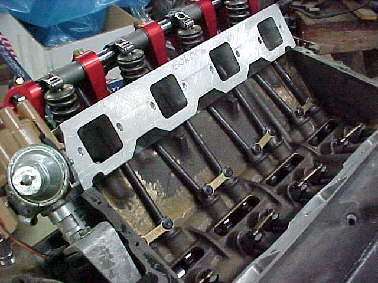
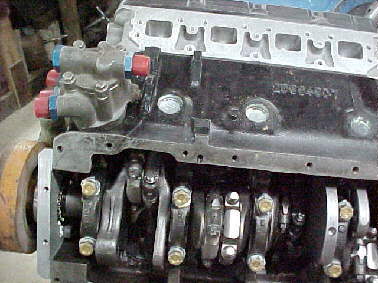 Left, the Hemi stroker, 4.38 bore, 4.375 stroke, 528cubic inch. Special Crane roller w/.590 lift and 246*, 252* duration @.050, Isky roller lifters. STAGE V cylinder heads, stainless rockers, anodized stands. Manley severe duty 2.25" intake, 1.94" exhaust valves. Chrysler triple valve springs, Comp Cams titanium retainers. 10.5:1
compression Ross pistons, Clevite77 rod and main bearings.
Left, the Hemi stroker, 4.38 bore, 4.375 stroke, 528cubic inch. Special Crane roller w/.590 lift and 246*, 252* duration @.050, Isky roller lifters. STAGE V cylinder heads, stainless rockers, anodized stands. Manley severe duty 2.25" intake, 1.94" exhaust valves. Chrysler triple valve springs, Comp Cams titanium retainers. 10.5:1
compression Ross pistons, Clevite77 rod and main bearings.
Right,
check out the F911 9/16" main cap bolts, and the
Keith Black
oil pump. 7.350" NASCAR rods, 1/2" rod bolts, with
special Crower
wrist pin bushings to reduce the pin diameter from
1.094" to .990". 3/4" raised exhaust port is visible
in this photo also.
Milodon gear drive, oil pan w/swinging pickup, and
valley cover heat shield. Mopar aluminum water pump
housing. I still need an aluminum water pump. I wont
need the distributor, but I will have to machine a plug
to hold the oil pump drive down in its place.

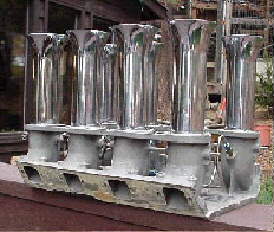 The
Electromotive TEC-II EFI, and Paxton fuel pump, right, should
flow enough fuel for this 2 7/16" Hilborn, left.
The
Electromotive TEC-II EFI, and Paxton fuel pump, right, should
flow enough fuel for this 2 7/16" Hilborn, left.
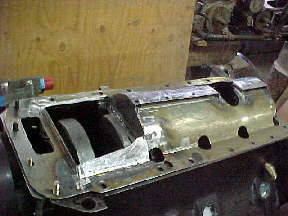
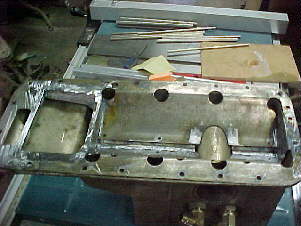 I bought this windage tray on ebay also. It was on a 4.25" stroke
maybe it will fit my 4.375" stroke. The stock Chrysler one
wont clear the bigger crank. My UPS man delivered this 1/2/2000.
This tray must have fit a Donovan 417 (if they had extended oil pan rails).
It is for a rear pump and very wide pan flange. Here is the modified windage tray.
The big hole about 2/3s of the way back is necessary to clear the tie rod tube
thru the oil pan (on Mopar A,B or E bodies) .
I bought this windage tray on ebay also. It was on a 4.25" stroke
maybe it will fit my 4.375" stroke. The stock Chrysler one
wont clear the bigger crank. My UPS man delivered this 1/2/2000.
This tray must have fit a Donovan 417 (if they had extended oil pan rails).
It is for a rear pump and very wide pan flange. Here is the modified windage tray.
The big hole about 2/3s of the way back is necessary to clear the tie rod tube
thru the oil pan (on Mopar A,B or E bodies) .  I will try to get a better picture, but this is a
MR GASKET
desktop dyno program run. Showing the possible power this beast might make.
The lower lines are using ported heads, while the upper
lines represent heads with "all the tricks". My heads fall somewhere
between. This is with mufflers. The program doesn't allow
enough cfm for the Hilborn, so this is 1600 cfm on a tunnel ram.
I will try to get a better picture, but this is a
MR GASKET
desktop dyno program run. Showing the possible power this beast might make.
The lower lines are using ported heads, while the upper
lines represent heads with "all the tricks". My heads fall somewhere
between. This is with mufflers. The program doesn't allow
enough cfm for the Hilborn, so this is 1600 cfm on a tunnel ram.